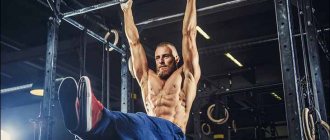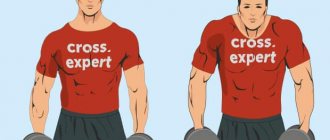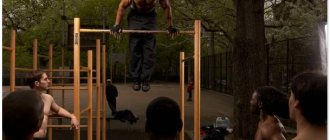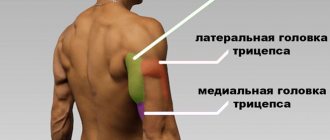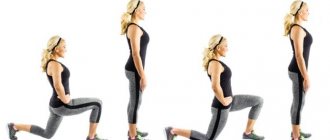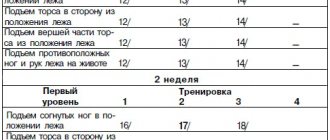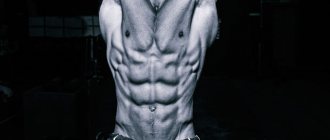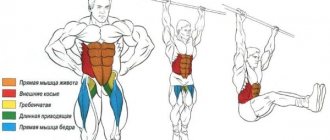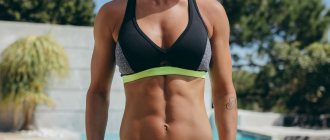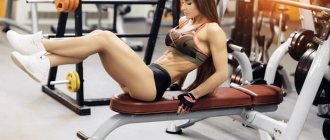Share:
The abdominal corner exercise is one of the most effective static tools for pumping up the abdominal muscles. Unlike dynamic loads, which promote muscle growth and the appearance of relief, static exercises allow you to increase muscle fiber strength and develop endurance.
Therefore, the “corner” abdominal exercise is less suitable for beginners. In addition, in order to achieve a toned figure, it is better to spend more time during the training process on dynamic exercises, and leave static ones to “finish off” the trained muscles at the very end. There are different variations of this exercise for different levels of training of the athlete. Next, we will look at the features of each of them, study the technique of execution, and also find out the effect on specific muscles when choosing a certain type of “corner”. The most popular types of this exercise are as follows:
- Corner on the floor;
- Corner on the wall bars;
- Corner on the horizontal bar.
Execution technique
Regardless of the type of exercise, the “base” is the athlete’s positioning of the legs and torso in a position that can be called a straight degree. The position of the back is maintained in a straight position, the legs are tightly connected together, fixation of the position lasts for at least 10 seconds.
Floor
This is where you begin to get acquainted with the statistical load on the abs, but the abdominal muscles are prepared during the transition to the lesson (a series of the classic approach is performed while lying down for 2 weeks). Breathing is voluntary, but as you exhale the muscles tense and then relax. The total time for fixing the legs in the air (per approach) takes 3 minutes, the break duration is 1 minute between sets.
Algorithm:
- lean on your buttocks and stretch your legs;
- lean your body on your hands;
- legs lift off the floor and stretch in the air;
- the limbs are directed towards the body and held.
It is recommended to keep your elbows straight, but a slight bend is allowed. A complicated technique involves placing your hands on the ground and lifting your legs, which become parallel to the floor.
Horizontal bar
Exercising on the horizontal bar is acceptable and beneficial for the abs. Hanging on a sports structure, the athlete raises his legs, holds his breath and pulls his toes towards the body. Experienced athletes take a series of rapid inhalations and exhalations, lowering their limbs in the final part.
Common mistakes:
- arch of the back;
- rocking;
- jumping from the horizontal bar.
When performing the exercise, keep your hands shoulder-width apart; when lowering, your elbows are not apart, but are directed towards the body.
Bars
Advanced load option: on the uneven bars the load is higher, because the athlete does not hang, but maintains the position with his torso using his arms. The athlete jumps onto the bars and tries to raise his legs above the level of the sports structure, and after crossing the mark, he holds the position for 3-5 seconds. The decrease in retention time is dictated by the increased load.
Complicated options for training on uneven bars:
- raise your legs to face level;
- hang weights on your feet;
- increase the holding time to 20 s.
To enhance the impact of the hands, they are bent at the joint (a push-up effect is created).
Swedish wall
At home or in the gym, perform the load comfortably on a wall bars adjacent to the wall of the room. The technique closely resembles the procedure for receiving a load created by a horizontal bar. However, the wall bars provide more options - hanging (while grabbing the top bar) and support (on the side handles). Some models do not contain protrusions, but attachments can be purchased and integrated into an existing structure. Exercises on the wall bars are carried out without lifting your back from the vertical surface.
"Corner" on the floor
The abdominal corner exercise on the floor is performed by lifting and holding the body on the hands in a fixed position. Recommended time: 30 seconds, 3-4 sets. It is no coincidence that we chose this type of exercise first, since we recommend that all beginners begin their progress in the corner with it.
Execution technique
- Starting position – sitting on the buttocks, legs straight with toes extended. The back is also straight. The arms are parallel to the body, and the hands rest on the floor.
- Now you need to use your hands on the floor and lift your shoulders to lift your buttocks off the floor. Important! When the body is lifted off the floor, the pelvis moves slightly back.
- Now, with the help of the muscles of the lower abs, the outstretched legs are lifted off the floor and held in weight for the maximum amount of time. And it’s not for nothing that our exercise has a geometric name - corner. So, as we know, the angle can be different. To start, you can keep your legs parallel to the floor. Over time, you can progress in the exercise by raising your legs higher and higher. The arms can be in three positions: straight, slightly bent at the elbows, and resting completely on the elbows.
There is no limit to perfection: for example, gymnasts hold the corner in such a way that their legs are very close to their face
Features of preparation
As can be seen from the technique of execution, this exercise will require the use of your arms - albeit small, but if you have very weak ones, then at some point you will stop progressing in abdominal exercises precisely because of your arms, which will not be able to hold the body straight in for a long time. If you encounter such a problem, we recommend alternating the corner with push-ups to strengthen the arm muscles. In addition, for progress on the abs, we recommend alternating the corner with strength exercises for the abs, for example, sit-ups and V-sit-ups - then the effect will be maximum!
If exercises in this form are difficult, you can make the method of execution a little easier. For example, it is much easier to perform a “corner” with your legs tucked to your chest:
© zinkevych — stock.adobe.com
Common mistakes
As with any other exercise in a corner on the floor, athletes make a number of mistakes when performing it. Let's look at them.
- Bend in the knee joints is considered a mistake. Legs remain straight with toes pointed forward throughout the entire workout. But! If you are a beginner athlete and you cannot hold out for 10 seconds any other way, then this option is acceptable during the first training sessions in the strengthening process.
- Shoulders should be raised. It is unacceptable to pull your shoulders into yourself.
How to pump up muscles on the horizontal bar?
With the help of a horizontal bar you can effectively work out all the muscle groups of the upper body. Let's figure out how to make your workouts on the horizontal bar more effective.
- Hands.
When working on the horizontal bar, you use the latissimus dorsi and arm muscles. To shift the emphasis of the load to the biceps and triceps, you need to use a narrow grip. You can also pump up your biceps more actively if you use a reverse grip. To shift the load on the triceps, a neutral grip is suitable, with your palms facing each other. - Back.
The best choice here is pull-ups. This is a very effective movement and there is no point in inventing something of your own. Exhale as you lift your body, and inhale as you move down. To evenly load all the back muscles, it is best to use a straight (palms facing away from you) grip slightly wider than the level of the shoulder joints. - Wings.
Wings in the language of bodybuilders are the latissimus dorsi muscles, or rather their upper section. To pump them up, you will need to use the widest possible reverse (palms facing you) grip. To maximally load the latissimus muscles, you will need the help of a friend. He should lift your legs at a 45 degree angle and hold. However, even without outside help, you can achieve excellent results with regular training. - Breast
. No matter what type of pull-up you do, your pectoral muscles will be actively working. But the maximum load on this group is achieved when using a medium straight grip, and you need to pull yourself up by your head. This is a rather difficult exercise, especially for beginners. Perform the movement in three sets with as many repetitions as possible. - Shoulder girdle.
The main muscles of the shoulder girdle are deltoids. To use them as much as possible when doing pull-ups, use a straight, narrow grip. The “Strength Out” exercise is also very effective. You should know it from school physical education lessons.
What muscles work when performing the Corner under different conditions?
Static hyperextension involves many muscle groups. The level of load on muscle fibers and the degree of their involvement in sports work depend on the technique of execution. Exercise Corner on the floor creates the main tension on the circular muscles of the lumbar region and the front surface of the thighs. Additionally, the gluteal groups and small stabilizers of the lower extremities take part in the work.
When performing techniques on the horizontal bar, the main load falls on:
- biceps;
- triceps muscle of the forearm;
- lumbar structures;
- muscle fibers of the spine;
- all press groups;
- back muscles.
When working on parallel bars, the following muscles are involved in the training process:
| Muscle | Anatomical characteristics |
| Iliopsoas | Refers to the internal muscle fibers of the pelvic area. It is formed by the fusion of the distal bundles of the greater and lesser iliac muscles. Responsible for flexion and supination of the femoral region of the lower extremities. |
| Extensor fascia lata | A flat and elongated muscular structure located in the anterolateral surface of the pelvic segment. Responsible for the tension of the lata segment of the fascia and the iliotibial tract. Serves as a pronator of the hip. |
| Tailored | The longest muscle in the human body. It has a spiral configuration and affects the muscular relief of the legs. Responds to strength abilities, performs flexion of the hip and knee joints, and provides rotational flexibility of the lower leg. |
| Straight femoral | Quadriceps, which occupies the entire front and part of the back of the thigh. Adjacent to the press groups and together with them participates in the work of pumping the lumbar muscles. |
| Comb | It is part of the medial group of the femur and has the shape of a quadrangle. Responsible for the strength and flexibility of the hip area. |
All types of static hyperstension weakly involve the muscular structures of the back, so you should not count on working them out with the help of such isometric exercises.
Benefits and harms
The corner is a popular exercise that allows you to form a press with parameters that are in demand in sports competitions. The benefits are also obvious for beginners - the body becomes attractive.
Benefits from doing the lesson:
- elimination of fat deposits on the abdomen;
- increased muscle fiber strength;
- increasing endurance;
- formation of a “wasp waist”;
- reducing the “orange peel” effect.
Threats lie in the strong tension that is exerted on the abdominal muscles, which remain in an unusual state for a long time. If you have certain diseases, harm from exercise is acceptable.
Development of pain syndrome with:
- cystitis;
- vertebral hernia;
- first month after birth;
- postoperative period.
Severe pain is possible in the presence of abdominal, inguinal or umbilical hernia, in which physical activity is completely contraindicated.
Warning: Cannot be performed in the presence of hypertension, arrhythmia, aneurysm.
Content
- 1 Corner: what muscles work?
- 2 How to make a corner?
- 3 Exercise variations
- 4 Number of repetitions and approaches
- 5 Additional materials
Hanging Corner Lying Corner Forearm Corner This auxiliary exercise is called the Forearm Corner. To perform it, you need a simulator that allows you to rest your forearms on the armrests while standing.
Performed by those who have reached at least an intermediate level. Helps stabilize the entire body.
The benefits of static exercise Ab corner
When performing such exercises, muscle structures are tensed without stretching. Isometric complexes involve holding the body in a static position and creating external resistance solely with your own weight. Exercise Corner on the floor engages the deep abdominal muscles, which are not involved in dynamic training. It activates blood supply to the muscle tissues of the lumbar area and lower extremities.
The technique allows you to effectively work out muscles located in hard-to-reach places. The obvious benefit of isometric exercise is to increase the flexibility of the ligaments and tendons with regular training. The likelihood of injury, unlike dynamic loads, is vanishingly small. The exercise improves the functionality of the ligaments and joints of the hip area, increasing their athletic performance.
The technique provides girls with the formation of an attractive figure and rapid weight loss, and gives men the opportunity to create muscular relief and increase strength abilities. This exercise is useful, safe and effective.
Isometric complexes can be performed by athletes after injuries, when the ability to use dynamic techniques is severely limited. It is static exercises in such a situation that ensure restoration of physical fitness and create proper muscle loads.
Obvious benefits of isometric exercises:
- maintaining a stable position of internal organs;
- improving the supply of oxygen to body and brain tissues;
- strengthening and increasing the flexibility of the spinal column;
- appetite suppression, which promotes weight loss;
- beneficial effect on the state of the reproductive system of women.
No exercise equipment or sports equipment is required for training. It takes minimal time. For beginner athletes and during the recovery period after injury, it is enough to exercise for 10 minutes. per day to achieve results and strengthen muscles.
Nuances
How to perform it correctly and how to learn to do the exercise without discomfort are other important questions that interest “newbies” who have unsuccessfully completed the exercise. Spasms, pain, tension are the consequences of incorrect tactics to give the lower body an attractive appearance.
Before starting a class, beginners make a common mistake - they start without warming up. Achieving a right angle the first time is also problematic, so for “beginners” a gradual increase in height is allowed.
Some athletes lift their limbs jerkily, which is unsafe. Experienced athletes have created other variations of the Corner that help increase the load.
- weights. Objects (light dumbbells) are placed on the ankle. This activity is suitable for people with highly developed abdominal muscles.
- increase in height. The legs are raised to an increased height. The load increases the flexibility of the body.
- leg spread. Classic execution on a horizontal surface, but with the limbs open. Holding each leg separately helps develop your thigh muscles.
- bent leg. The second limb remains straight (alternately changing), the exercise helps to tighten the oblique abdominal muscles.
Unlike other exercises, it allows you to visually highlight all six abs, but other techniques often do not allow you to work out the lower 2 abs. Muscle blocks are hidden behind a layer of fat, which can be easily removed with static exercise.
It is not recommended to do it in an overexcited state: the smoothness of the movements requires the presence of inner peace.
What is a lower press
This is the lower part of the rectus abdominis muscle. Since both the upper and lower abs are the same muscle, it is impossible to train the lower abs in isolation. Any abdominal exercise works the entire rectus abdominis muscle, but some movements work the upper part more, while others work the lower part.
The upper press is marked in blue, the lower – in red.
A little theory, and you yourself will be able to distinguish which exercises better load the upper abs and which ones better load the lower abs.
If you lift your chest with a fixed pelvis (twisting, folding, various lifts of the body), the upper press is more heavily loaded: the amplitude of its movement is greater.
To load the lower part of the abs, you need to raise the pelvis with a fixed chest. Not just the legs, but the pelvis.
When lifting your legs, the abs also come into play, but at the same time, the muscles that flex the hip experience greater stress. To properly load the abs, you need to tilt the pelvis back. And it doesn't matter in what position you do it.
The video below shows at what point in lifting the legs the rectus abdominis muscle comes into play: when the upper part of the pelvis tilts back.
That's all you need to know about lower abs training. Now let's move on to the exercises.
Raising legs and knees on the bar (2-3 approaches):
We hang on the horizontal bar, begin to raise our straight legs to the crossbar
, we do it without jerking or swaying, smoothly. For example, if you can’t do it 10 times right away, that’s okay. Raising straight legs is just the first stage.
When you have done the maximum number of times, raise your legs to the horizontal bar - DO NOT jump to the ground. Now we begin to raise the bent legs to the chest
. the oblique abdominal muscles very well
, if you raise your knees not directly to your chest, but to the left and right, i.e.
twist left and right
.
And we do this exercise until we feel a burning sensation in the abdominal muscles, and we can’t pull any more :)
The above exercise pumps up the abdominal muscles very effectively and takes little time. Also, at the same time, you train the grip of your hands and your forearms.
how to pump up your abs
A man with six-pack belly instead of folds is every girl’s dream. Representatives of the stronger half of humanity with such abs are considered incredibly sexy and beautiful. But they exist not only on magazine covers, any man can decorate his athletic figure with pumped up abs, for this we offer a set of exercises on a horizontal bar or a regular crossbar, which can be mounted even in an ordinary city apartment.
the best exercise for the oblique abdominal muscles is the frog
For beginner athletes. Grab the bar of the bar and hang. Now raise your legs with your knees bent. Pull them up until your kneecaps touch your chest. In this case, the lower and oblique abdominal muscles begin to work very well. After you master this type of exercise, try to complicate the task for yourself.
frog abdominal exercise
Raise your legs straight, not bent, until they are parallel to the floor or ground. Experienced bodybuilders say that this simple exercise, in terms of technique, is one of the most effective exercises for the oblique abdominal muscles. The minimum number of sets for beginners is 5, for advanced ones – 10, and for experienced ones there is no limit.
exercises on the abdominal bar - inverted hatchet
The starting position for this exercise is upside down. Hold onto the bar of the horizontal bar with your knees bent (you probably hung on the apparatus like this as a child). Hands clasped in front of you. Now raise your body until your chest touches your knees. Return to starting position. Do several sets.
exercises on the horizontal bar for the press - corner
Start this exercise only when you have mastered the previous two – “frog” and “inverted hatchet”. Starting position – hanging on the bar, legs straight. The technique of execution is elementary, but the press experiences very serious loads. You need to raise your legs straight until they are parallel to the floor. The required point has been reached, but now do not let go of your legs, but fixate in this state for two to three seconds. Now you can relax and let go of your legs. It’s easy to get to the point where your body just starts to flop around and sway—this is the enemy of effective exercise. You must constantly ensure that the body is static, literally taut like a violin string.
abdominal exercise corner
As soon as you notice that there are already ways to do these tasks, when they no longer seem difficult, then you can easily pull your legs up, not to your chest, but to the bar itself. The classic rule of turnstiles applies here - take your time, do all exercises without twitching or jerking. Everything should be very smooth and beautiful. This way you will protect yourself from injuries and significantly increase the effectiveness of your training.
Sets and number of repetitions
When looking for answers, everyone should proceed from the state of their own body, its level of training. In this case, you are your own coach - ask yourself strict questions, but don’t go too far. Once thirty to forty leg lifts no longer pose a challenge for you, try making the task more difficult for yourself. Buy special weights in any sporting goods department. There are those whose weight can be gradually increased. Purchased weights can be replaced with homemade ones. It will be effective if you hang your backpack (not empty, of course) behind your back. Sets of exercises using weights are very good, so you shouldn’t avoid them, we’re working for results.
how to pump up abs on your stomach and not rip it off?
We simply have to mention the most common mistake of many novice athletes. Beginners believe that in order to achieve maximum results in the shortest possible time, they need to pump up the abs and other muscles without days of rest. What about days! They go to the horizontal bars several times a day! This is strictly prohibited. Every day, putting stress on the abdominal muscles, they will stretch more and more step by step. Excessive loads will give you the long-awaited cubes, but they will decorate not a chiseled abs, but a huge belly, which cannot be called in any other way.
a few additional exercises to pump up your abs
If you want to reduce the time it takes to achieve results, then it’s better to add a few more very simple exercises to your standard exercises, which don’t even require a horizontal bar. These exercises for pumping up the abs are familiar to you from physical education lessons; they are elementary, but at the same time they will keep your abdominal muscles toned without putting a lot of stress on them.
- Raising the body from a lying position. During lifting, hands should be held behind the head, fingers crossed. The legs should be static; secure them with something so that they lie flat on the floor and do not rise.
- Starting position – stand on your feet, feet shoulder-width apart. Now bend your body forward. In this state, turn your torso from side to side. The body must be parallel to the floor.
What to replace
Running frog
If there are physical limitations or difficulties in performing the activity, it is wise to choose alternative options for exposure, but also those that will also help to draw the relief.
- Press while standing. Having taken a position against the wall, a person alternately raises his limbs and connects them with the lowering arm.
- Wah. The athlete grabs the horizontal bar and bends his legs at the joints. The torso rises 25 times. The recommended number of sets is 3, breaks between sets are half a minute.
- Bike. It is practiced on the uneven bars, imitating the movements that are used when riding a bicycle. Work until you feel tired.
- D. In the prone position, the legs are raised and touch the outstretched arms (palms facing down). The exercise is made easier by relieving tension from the back. A set for taking the “G” position consists of 10–20 repetitions.
- Twisting on blocks. The athlete kneels, grabs the cable and, as he exhales, begins to bend towards the floor. As you inhale, you return to the starting position.
It is also useful to use a sports bench, which will help to effectively work out the lower abs.
Leg corner apart
More strength element (the load on the hips increases significantly). The physical conditions for its implementation are more demanding than with the previous corner. The legs are pulled upward by force, but maintain a horizontal position (for good performers, they are located at the level of the elbows). The lowering of the legs is prevented by the hands, which constantly press down and back on the floor; this effort is facilitated by the raised position of the head.
During the execution of the leg corner, the back is strongly rounded and, as it were, tends to a horizontal position, and the whole body is folded at the hip joints.
General characteristics, benefits of the exercise
This type of pull-up is a more complicated version of the regular pull-up. Over time, when basic exercises are sharpened to the limit, the muscles no longer exert enormous effort and develop more slowly. Therefore, there are various complicated versions of certain exercises for an advanced level that should be included in your training plan.
The benefits of corner pull-ups are as follows:
- this is one of the most accessible exercises: there are horizontal bars in every yard, and it’s not difficult to go outside and do a couple of exercises;
- Corner pull-ups can significantly strengthen the muscles of the back, arms, abs, chest and shoulder girdle;
- coordination of movements improves;
- develops strength and endurance;
- strengthens posture and spine, which helps prevent diseases of the musculoskeletal system;
- muscle spasms are eliminated.
Five of the most useful exercises for strengthening the spine
A person's appearance , his gait, and the way he moves can say a lot about his health . When the spine is healthy, a person walks easily, freely, and does not feel his body. If alignment is disturbed, then this affects other functions of the body: the respiratory, cardiovascular, digestive, and excretory systems suffer. Many people suffer from headaches, they take medications to no avail, and the reason often lies in osteochondrosis of the cervical spine , when the arteries of the cervical vertebrae are additionally pinched and the brain is less well supplied with blood.
By the way, vision also suffers from poor circulation. Only physical exercise will help strengthen and improve the overall health of the spine. When the vertebrae are normally stretched, the nerve endings are not compressed, the passage of nerve impulses to various organs and tissue nutrition improves. By performing these exercises, the spine lengthens and the muscles that support it in an already stretched state are strengthened. It’s not for nothing that they say: if you lengthen your spine, you lengthen your youth.
I would like to present to you the 5 most useful exercises for the spine, by regularly performing which you can work out and train all parts of the spine in a variety of ways - cervical, thoracic, and lumbar, strengthen the ligaments and muscles that support it. As a result, your posture will improve, your internal organs will become stronger, and you will begin to breathe correctly. In order for the process of healing the spine and all its parts to take place, these 5 exercises must be done regularly - daily or at least every other day. The floor surface should be flat and hard; for exercise you will need a mat, thin mattress or terry towel.
1 Exercise. Rifles.
I.p. – sitting on the floor, pull your legs towards your body, the soles of your feet should be pressed against each other. Wrap your hands around your legs at the ankles, pressing your chin to your knees. In this position, the back of the head, neck and back form one arc. Roll back onto your back and return to the starting position. Roll on your back 10 to 20 times, breathing randomly. Important: rolls should only be performed on a flat floor, so as not to displace the vertebrae.
Effect: this is a very beneficial exercise for the spine - it strengthens the spine and develops flexibility, and thereby helps in the treatment of diseases such as rheumatism, brain diseases, and in addition, the exercise strengthens memory.
After the exercise, relax a little and move on to the next one.
2 Exercise. Cobra.
I.p. - lying on your stomach, face down, heels and toes connected, chin resting on the mat. Place your hands on the floor and lift your upper torso as high as possible without lifting the lower half of your abdomen up to your navel. Throw your head back as far as you can, your eyes looking up. You need to breathe through your nose, randomly, then slowly return to the starting position. Repeat the exercise 5-10 times.
For those who can already easily do this exercise, here is a more complex version:
Perform all the movements as described above - bend up and back, and then turn your head over your right shoulder so that you can see the heel of your left foot. It is important that the arms and legs remain in place and the lower abdomen does not come off. Slowly turn your head forward and do the same, but turning your head over your left shoulder to see the heel of your right foot. Then bend up again, slowly throw your head back and return to the starting position, lower yourself down. Repeat the exercise, but following a different sequence of movements - up, left, right, up, down.
When performing this exercise, it is important to make smooth movements, stay in each position for half a minute, for this you can slowly count to yourself to 30.
Effect: the spine becomes more flexible, stoop and other curvatures of the spine are eliminated, beautiful posture appears, the functioning of the entire digestive tract improves, in particular, intestinal motility increases, and it is also good gymnastics for the eyes. With this exercise you can cure radiculitis.
3. Exercise. Triangle.
I.p. – standing on the floor, spread your legs wide enough, the distance between your legs is about a meter. Stretch your arms to the sides, palms down. Slowly lean to the left until you feel tension in your right side. Strive to reach your left foot with your left hand, your right arm is extended horizontally above your head, do not bend your legs! Stay in this pose for 5-8 seconds and then return to the starting position. Do the same in the other direction - to the right. Perform 3-5 bends in each direction.
For the more advanced, a more complicated option, but very useful for the spine, since it strengthens the lumbar region and thereby treats radiculitis:
Take the same starting position as described above. Slowly bend down while rotating at the waist, with your right hand moving towards your right leg until it touches it, your left hand raised up. The gaze is directed to the fingertips of the hand raised vertically upward. It is important to keep your legs and back straight during the exercise! Hold this pose for 5 seconds and return to the starting position.
Repeat the bends in both directions at least 3 times.
As you can see, in this exercise in the lumbar region there is not only stretching, but also twisting, the vertebrae move more and this helps to relax the intervertebral discs. The lumbar region is better developed and at the same time strengthened.
Effect: The exercise strengthens the muscles that support the spine, its flexibility develops, in the first option the lateral surfaces of the body are stretched, which is good for the waist, and in the second option the lumbar spine is well worked out and strengthened.
4 Exercise. Onion.
This exercise also has a second option, for advanced ones, it is more difficult, but over time, you will be able to do it too:
Perform all the movements as described in the exercise above and then, while holding your breath, do 4-5 rocking back and forth, return to the starting position, relax.
Effect: the exercise strengthens the gastrointestinal tract, forms a beautiful bust in women and strengthens the chest, and most importantly, it eliminates all deficiencies in the development of the spine.
5. Exercise. Fish.
The exercise consists of two parts - the first is aimed at stretching the spine, and the second part consists of vibration exercises for the spine, as a result of which the intervertebral discs are worked out, the cells are cleansed of toxins, and blood circulation is normalized.
I.p. -lying on your back, arms outstretched raised and lying behind your head, legs straightened forward, toes pulled towards you. Begin to stretch your legs one at a time, moving your heels forward a little - first the left, then the right, slowly counting to yourself to 5. Do a few of these nice, stretching movements. Then put your hands behind your head, under your neck, elbows on the floor, bring your legs together, pull your socks towards you. In this position, begin to oscillate left and right, like a fish in water. It is useful to do this exercise for 2-3 minutes in the morning and evening.
Effect: the exercise promotes the formation of individual vertebrae in their places, eliminates scoliosis and other curvatures of the spine, enhances intestinal motility, and normalizes blood circulation.
You can include these exercises in your morning exercise routine. By regularly performing these exercises to strengthen the spine, in just a couple of weeks you will feel that its condition will improve significantly, the pain will go away, and it will become easier for you to bend and straighten when bending. In addition, you will acquire correct posture and breathing, and become more resilient.
Do not try to immediately perform the recommended number of repetitions; start small - with 2-3 repetitions of each exercise. Remember that all movements must be performed at a slow pace, fixing and holding in each position (start with 5 seconds and work up to 30 seconds) in order to make the muscles stronger and stronger, better able to support the spine. If your muscles hurt and feel tired the next day, reduce the number of repetitions, but do not stop doing the exercises. After a few sessions, muscle pain will go away as you become more trained.
Only daily work aimed at working out the main parts of the spine will help you cope with radiculitis, cervical osteochondrosis, and other spinal problems. Remember to spend at least half an hour a day to keep your spine in good condition. After all, beautiful posture, a flying gait, and the condition of all internal organs and systems in the human body depend on his health.
Source
Training. Hold the corner for 10 seconds. Everyone should be able to
This article can be applied to both men and women. For athletes who are interested in the workout movement, it is worth studying the basic simple elements. Today we will talk about static corner holding. The physical trainers teach us to do a simple leg lift on the wall bars, and I will teach us to hold our legs for 10 seconds.
It's really simple and not difficult. And it is in this element that it is not the 6-pack or a big belly that decides, but the internal strength of the abdominal muscles. I was convinced of this by the example of guys with beautiful abs who find it difficult to hold the corner for 8-10 seconds.
I always try to achieve body functionality rather than muscle aesthetics. This is the real street workout.
Corner pull-ups. What, why and why?
I couldn’t bear to get married; we didn’t consider all the different types of pull-ups, but we somehow passed over the corner pull-ups. In vain? Of course, in vain, because this is a two-in-one exercise: not only for the back, but also for the abs. But let's not get ahead of ourselves and tell you about everything in order. Go!
Note: For better assimilation of the material, all further narration will be divided into subchapters.
Muscle atlas
The exercise belongs to the class of basic ones with a pull type of force and is aimed at working out the back. The muscle ensemble includes the following units:
- targeted – latissimus and rectus abdominis muscles;
- synergists – brachial and brachioradialis muscles, biceps, teres major and minor, infraspinatus, rhomboid, levator scapulae, middle and lower trapezius, posterior delta, pectoralis minor;
- dynamic stabilizers – triceps (long head).
A complete muscle atlas looks like this:
Advantages
By performing the corner pull-up exercise, you can expect to receive the following benefits:
We recommend reading: Aerobic exercise - what is it, examples
- development of the muscles of the upper shoulder girdle and back;
- improved back detail;
- development of back width, giving the body a V-shape;
- development of isometric strength of the abdominal and core muscles;
- strengthening grip.
Execution technique
Corner pull-ups are a high level of difficulty exercise. The step-by-step execution technique is as follows:
Step #0.
Approach the horizontal bar. Grab the bar with your hands shoulder-width apart or slightly wider. Close your legs together and lift them up to a 90- degree angle. Statically tighten your abs. Direct your gaze forward. This is your starting position.
Step #1.
Inhale and as you exhale, keeping your lower body motionless, begin to pull yourself up by contracting the latissimus dorsi muscles. Keeping your legs parallel to the floor, perform a pull-up while fixing your head above the horizontal bar at the top point for 1-2 counts and slowly and under control return to the IP position. Repeat the specified number of times.
In the picture version it looks like this:
Variations
In addition to the standard version, there are several variations of the exercise:
- parallel grip;
- reverse grip.
We recommend reading: TOP 8 questions about cardio training
Secrets and subtleties
To get the most out of the exercise, follow these guidelines:
- throughout the entire movement, do not move your legs, maintain an angle;
- do not look at your feet, do not lower your head down;
- when performing movement, do not use inertia/swing;
- when going down, do not fully extend your elbows;
- go down slowly and under control and quickly, explosively up;
- at the top point of the trajectory, fixate for 1-2 counts and squeeze the latissimus dorsi muscles;
- in each repetition, bring your chin above the bar;
- breathing technique: inhale - when going down, exhale - when going up;
- numerical training parameters: number of approaches/repetitions – 3-4/12-15.
We're done with the theoretical side, now let's look at some practical points.
Are corner pull-ups a good exercise for your back?
According to a number of studies (journal of the International Society of Electrophysiological Kinesiology, 2016-2019 ), the electrical activity of the latissimus dorsi muscles in L-pull-ups is comparable to classic pull-ups - 100% MVIC versus 120% MVIC. In addition, the percentage of abdominal muscle activation is twice as high as the classic version and is 50% versus 25% .
How to pump up your back on the horizontal bar
It is worth understanding that for this you need to initially have a certain physique: height up to 185 cm, weight up to 85 kg, wrist girth from 16.5 to 18, not heavy at the bottom. It will be easier for people with such initial data to master pull-ups. And here is what training program you can use to pump up your back on the horizontal bar.
- duration: 24 weeks;
- number of training sessions per week: 2 , Monday/Friday;
- exercises: wide grip pull-ups; reverse grip pull-ups; corner hang ( 4x90 sec); L-pull-ups;
- number of approaches/repetitions: 4x12-15 .
Use this PT, and in just six months you will pump up your back. Actually, in terms of content, that’s all. Let's move on to...
Don't neglect your warm-up!
And of course, we should not forget that any workout should begin with warming up the muscles, and the better the warm-up, the less chance of getting microtrauma during the workout.
In the classic form, the warm-up is carried out from top to bottom. First, stretching exercises are performed, after which the body is warmed up, from the neck to the ligaments of the legs.
However, to save time, you can limit yourself to exercises for the lower back. Tilting your torso in different directions for 3-4 minutes will be enough. You should feel improved flexibility and a surge of warmth in the part of your body that you are kneading.
The horizontal bar is a universal tool for building the body, and in addition to the abs, you can pump up almost all muscle groups on it, don’t forget about it.
So, having an arsenal of theoretical knowledge in stock, you can create a body that you cannot look at without admiration.
